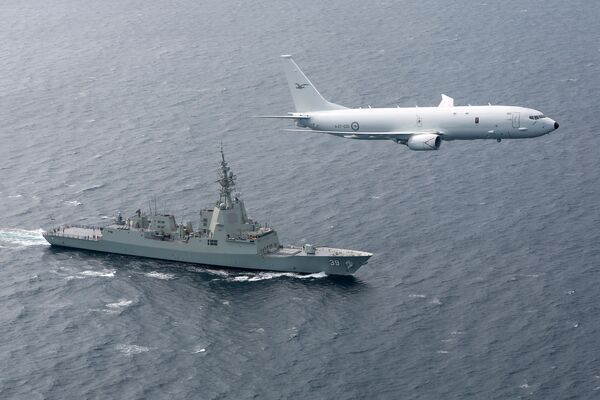
A RAAF P-8A Poseidon MPA works with the RAN guided-missile destroyer HMAS Hobart . The maritime air power provided by the P-8A is integral to lacing together the RAN's capabilities and outputs. (Commonwealth of Australia)
For a decade or more, Australia has been transforming the outputs of the Royal Australian Navy (RAN) through a fleet-wide recapitalisation of its force structure. This process began with the acquisition of two Canberra-class landing helicopter dock (LHD) amphibious assault ships (HMA ships Canberra and Adelaide), commissioned in 2014 and 2015, respectively. The LHDs were followed by three Hobart-class air warfare-focused guided-missile destroyers (DDGs). HMA ships Hobart, Brisbane, and Sydney were commissioned in 2017, 2018, and 2020, respectively.
In 2021, two new Supply-class replenishment vessels, HMA ships Supply and Stalwart, arrived.
The next new ships will be the Arafura-class offshore patrol vessels. Of the 12 planned hulls, one is in the water and four are in build. After that come the Type 26 Hunter-class anti-submarine warfare (ASW)-focused frigates – nine are scheduled, with initial operational capability (IOC) scheduled for the 2030–32 timeframe.
Alongside delivering new ships, the RAN has been upgrading its in-service MEKO 200 Anzac-class frigates and Collins-class diesel-electric submarines (SSKs).
Atop this renewed force structure, and underpinning it in operational terms, will be a fleet of nuclear-powered attack submarines (SSNs), to be delivered under the Australia-UK-US (AUKUS) programme. This SSN fleet will be established initially, from the early 2030s, using three (and perhaps as many as five) US Navy (USN) Virginia-class SSNs. From the late 2030s, the AUKUS programme will begin delivering SSN-AUKUS, a new boat designed both for the RAN and the UK Royal Navy (RN).
Looking to read the full article?
Gain unlimited access to Janes news and more...



